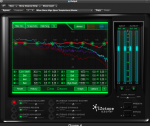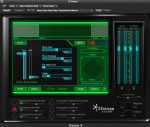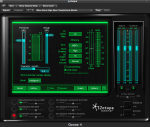Okay y'all I'm pretty new to this forum, but I do not feel that I am new to mixing music. I don't think you can be a a master at mastering, unless you went to school for it (no pun intended). However, I have read a good bit about it. Well I have been using Izotope Ozone 4 and I really liked the youtube videos created by "Dj Vespers" and "fordeetv", they seemed kinda simple. However I am very confused as the first song I used tried to master came out lower than the original mix. Ok, Just to start i lowered the mix to -6db. Then I took it in to the Ozone 4 program. The song is actually a freestyle over 2pacs Temptation ... So I used the matching eq feature. I have included some screenshots, can someone tell me where I went wrong? I used the Ozone 4 features I understand; Eq,Reverb and Maximizer/Limiter.Original Mix (Clipping at -0.2 decibels) via Izotope Ozone 4. Will send the link directly if anyone wants to hear!
You are using an out of date browser. It may not display this or other websites correctly.
You should upgrade or use an alternative browser.
You should upgrade or use an alternative browser.
Izotope Ozone 4 Mastering Issue... Why is my original mix louder?
- Thread starter Ziti
- Start date
deRaNged 4 Phuk'dup
Moderator
I think your input/output fader was moved down at some point?
EDIT: No, I think that's default? RMS?
EDIT: No, I think that's default? RMS?
Last edited:
I don't use Izotope, but it the output is set to -15dbfs, then that might mean you lowered the max peak to -15dbfs. So, that's probably why it sounds lower. If you got your mix to -6 dbfs by turning down the master fader, that's the other part of the problem.
Nah i lowered the individual faders each by a little over -6db since the track was clipping at 0.2db when in the mix... Quick question for all my users familiar with maximizers/limiters. When I'm lowering the threshhold .. for example the screenshot shows -4.9db..does that mean its maximizing/raising every signal thats hitting at -4.9db and above, up to the -0.3 Margin(db)
Just trying to brush up on my knowledge!
Nah i lowered the individual faders each by a little over -6db since the track was clipping at 0.2db when in the mix... Quick question for all my users familiar with maximizers/limiters. When I'm lowering the threshhold .. for example the screenshot shows -4.9db..does that mean its maximizing/raising every signal thats hitting at -4.9db and above, up to the -0.3 Margin(db)
Just trying to brush up on my knowledge!
You are becoming confused by the paradox of power. More signal is more power, it is essentially making more of the sound heard at lower and lower monitoring/playback volume, sounds that otherwise might be below the perception threshold at those playback levels. But that should not be understood as loudness, loudness is totally separate. Loudness is how well the frequency response of that signal aligns to the frequency sensitivity curve of your ears. If the signal happens to be such that the limiter acts on it to unalign the signal from the frequency sensitivity curve of your ears, then your limiting might give you more power and less loudness. It might make certain frequencies more audible at lower volume, but your aim at making it louder is failing. When you limit, you use the limiter's attenuation meter to determine the amount of signal reduction it does. If you lower the threshold to -10 dB, it means the limiter starts to act on the signal when the level exceeds -10dB.
Be aware that the summed signal contains a set of sound sources with their individual dynamic ranges present inside of that summed signal. In many cases it is not appropriate to limit the whole mix as if they all have the same dynamic range. You need to be aware that limiting the signal this way can make it very flat sounding, depending on the incoming signal. How flat, is determined by the signal capacity of your setup in combination with your monitoring process. The signal works on a cumulative voltage curvature. Why this matters, is because the more available headroom you have to work with in combination with the more accurate your monitoring process is, the less dramatic gain modifications you are naturally going to have to make relative to the original recording because each step higher or lower is going to have such a dramatic impact at those overall power levels due to that cumulative voltage curvature, which means the dynamic range of all sound sources are kept within certain "good" ranges prior to the loudness increase. Commercial mixes are able to "swim in sweet bouncing" because of this. If you would compare a mediocre setup A with a max signal capacity of say 2.4 volts (e.g. a Focusrite Scarlet 2i4) and a more pro setup B with a max signal capacity of say 21.8 volts (e.g. a Benchmark ADC1/DAC1), then allow the same engineer balance the mix in both setups using an identical monitoring process, you will notice that the final input track balance is going to be totally different in both of these DAWs, hence the dynamic ranges are going to be different and the impact of the loudness increase is going to be different. In setup B the engineer can take advantage of the cumulative voltage nature, minor gain increases and decreases will result in a balanced mix because every step at that signal level is going to have such a dramatic impact on the perceived signal. On the other hand, when the engineer works in setup A, he is going to have to push certain sounds so that they fall below the perception threshold at normal playback volumes, hence this in turn will make him overreact during the limiting process and now he is pushing the already flat sounds to their death. Imagine then what the difference is between a high signal capacity highly accurate monitoring environment, compared to a low signal capacity highly inaccurate monitoring environment, in combination with a mastering engineer that just goes for it with a brickwall peak limiter on the mix bus. Flat sound does not produce a beautifully bounced sound.
You can fight the effects of signal capacity limitations by turning down the monitoring volume on the hardware. The only thing that resolves the issue is to fix them, but by monitoring at a fairly low volume you can at least lessen its impacts somewhat... It can also pay off to balance the kick, snare and bass guitar in the context on a little louder volume with the vocals muted. This will bring the vocals more up front when you mix those in on lower monitoring volume. So by taking advantage of the monitoring process and monitor effectively, you can somewhat lessen the overall impacts of limited headroom.
Last edited:
The Burglar
New member
Yah. Could be the threshold level on the limiter or compression in ozone. When you lower the threshold it cuts off at a lower db. When you raise it it allows more volume to pass. Check the ratio as well. Example 2:1 means the db is multiplied by that amount ect. It could be the routing of your tracks too. You can try creating a audio track that act like a pre master with a limiter, eq whatever effect you want then route into your actual master that has ozone for the final. I know with ozone5 all you have to do is turn up the two master faders you see on your right. Not sure about 4 never used it
Last edited:
laurend
Active member
In a maximizer such as Ozone, the threshold value corresponds to the invert of the input gain applied to the limiter section. With the used setting, the mastered track shoud be + 4.9 dB louder than the original one. Obviously, the gain has been lowered elsewhere in your mastering chain.



